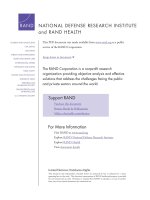Neurology a clinician’s approach 2016
Bạn đang xem bản rút gọn của tài liệu. Xem và tải ngay bản đầy đủ của tài liệu tại đây (12.45 MB, 437 trang )
Andrew Tarulli
Neurology
A Clinician’s Approach
Second Edition
123
Neurology
Andrew Tarulli
Neurology
A Clinician’s Approach
Second Edition
Andrew Tarulli
Beth Israel Deaconess Medical Center
Harvard Medical School
Boston, MA, USA
ISBN 978-3-319-29630-2
ISBN 978-3-319-29632-6
DOI 10.1007/978-3-319-29632-6
(eBook)
Library of Congress Control Number: 2016931864
© Springer International Publishing Switzerland 2016
This work is subject to copyright. All rights are reserved by the Publisher, whether the whole or part of
the material is concerned, specifically the rights of translation, reprinting, reuse of illustrations, recitation,
broadcasting, reproduction on microfilms or in any other physical way, and transmission or information
storage and retrieval, electronic adaptation, computer software, or by similar or dissimilar methodology
now known or hereafter developed.
The use of general descriptive names, registered names, trademarks, service marks, etc. in this publication
does not imply, even in the absence of a specific statement, that such names are exempt from the relevant
protective laws and regulations and therefore free for general use.
The publisher, the authors and the editors are safe to assume that the advice and information in this book
are believed to be true and accurate at the date of publication. Neither the publisher nor the authors or the
editors give a warranty, express or implied, with respect to the material contained herein or for any errors
or omissions that may have been made.
Printed on acid-free paper
This Springer imprint is published by Springer Nature
The registered company is Springer International Publishing AG Switzerland
To my wife, Susan, and my daughter,
Madeline.
Foreword
A month before I started my neurology residency, a copy of Andrew’s book was
given to me by the departing neurology chief residents. Attached was a letter, the
thinly veiled point being that this should be read (and possibly re-read) prior to
starting the junior year. What an invaluable early influence it became. Perhaps so
much so, in fact, that I now find it hard to remember a time when my cognitive
framework for analyzing a patient’s complaint seriously differed from that which
Andrew’s book provides.
Therein lies its strength; as the title suggests, this really gives the student an
insight into the clinician’s approach. Clinical reasoning is the absolute bedrock of
neurology; knowledge of a thousand obscure diagnoses or mastery of neuroradiology or neuropathology is useless unless there is a level-headed approach to using
the history and a focused exam to sort out a complaint. Though there are many
published compendia of facts, no other book provides this conceptual framework of
learning how to think properly at a level which can be accessed by the medical student or junior resident. They need to be taught how to think like a neurologist from
the start. This niche, crucially important, is rarely filled.
I had the privilege of being the chief resident on the stroke service in July and
when my junior residents arrived, they asked me which books they ought to buy. I
gave them a long list, but I made sure to explain why Andrew’s should be the first
to be read. I think that is true for any medical student, future neurology resident (or
current resident who has not done so), and internist.
Beth Israel Deaconess Medical Center
Harvard Medical School
Boston, MA, USA
Marc Albert Bouffard, M.D.
vii
Foreword
Since the time of Hippocrates, there has always been, and there probably always
will be an element of apprenticeship in learning to be a physician: both figuratively,
in that by reading a single-author text we absorb the condensed insights of an experienced predecessor, and quite literally since the art of history taking and technique
of the physical exam cannot truly be grasped from reading alone. In neurology in
particular, where even today modern imaging and sophisticated electrophysiology
cannot supplant a careful history and exam, our clinical skills are a composite of
what we once saw particularly well demonstrated by one or another of our teachers,
adapted to and modified by our own needs and experiences. We are always indebted
to the ones who taught us.
At the very beginning of my neurology training, I was doubly fortunate to work
with Andrew as the first attending on my first month on the neurology wards and, at
nearly the same time, to read Neurology. A Clinician’s Approach as my first clinical
neurology book in residency.
The move from the previous year of medical internship to neurology proper was
at first exciting, even exhilarating (it was, after all, my chosen field) but even so it
was not easy. The year in internal medicine was of course an important preparation
in many ways. It taught me the mechanics of being a doctor and an understanding
of the inner workings of the hospital, and it certainly provided a solid clinical foundation. Nevertheless, it could not have prepared me for the subtleties and complexities of clinical neurology, where the difference between a trivial condition and a
malignant brain disease sometimes hinges on the size of a pupil or the exact pattern
of weakness in a limb. From big textbooks to online databases, there was certainly
no lack of information, and everyone from my chief residents to Dr. Clifford Saper,
the neurologist-in-chief, was handing out papers and references. But where was the
key to all this knowledge? Andrew’s book provided exactly the guidance I needed
at this time of transition—to paraphrase William Osler, it became the first chart to
help me sail the sea of neurology. It went straight to the point: here were the 23 most
common neurological chief complaints and diseases, and practical approaches to
each one of them. Just like Andrew’s personal teaching, his writing is easy to follow
and logical in its organization, and while always concise, it does not shy away from
ix
x
Foreword
thoughtful discussion where appropriate. It has clinical pearls in abundance but at
the same time it is always full of common sense. Each year since, I have been recommending it to the incoming neurology residents and medical students on their
neurology clerkships. I was thrilled to hear of the new edition of the book, and I am
happy that the next generation of trainees in neurology will likewise profit from
Andrew’s guidance in learning how to approach and care for patients with neurological illness.
Massachusetts General Hospital
Harvard Medical School
Boston, MA, USA
Bart Chwalisz, M.D.
Preface to the Second Edition
In 2010, I began the preface of the first edition of Neurology: A Clinician’s Approach
by asking whether the world needed another introductory neurology textbook. I was
uncertain about the answer then, and the availability of electronic resources that can
be updated instantaneously to reflect new developments in biomedical science renders the necessity of such a book even more doubtful. Nevertheless, books like this
one do have their place: a brief and finite survey text is more valuable to new neurology residents and students than a web of information in which a newcomer will
be entangled easily.
Neurology has changed a great deal since 2010. Powerful new treatments are
available for stroke, epilepsy, and multiple sclerosis. Paraneoplastic syndromes
have been identified as underlying once mysterious disorders of the nervous system.
New imaging techniques capable of defining pathology in Alzheimer disease and
Parkinson disease are being incorporated into everyday practice. At its core, though,
the practice of neurology is unchanged. It is done at the bedside and needs to be
approached with the same classical techniques of history taking, directed examination, and localization that trace their roots back to Charcot and the other pioneers of
neurology of the nineteenth century. Introducing the reader to these techniques
remains the focus of Neurology: A Clinician’s Approach.
I would like to reiterate my gratitude to those who have trained me and those
whom I have had the privilege of training. Drs. Clif Saper, Mike Ronthal, Frank
Drislane, and Penny Greenstein remain towering influences in my approach to neurology. Neurology: A Clinician’s Approach persists as a tribute to their expertise as
neurologists and to the personalized attention that they gave me during my residency training at Beth Israel Deaconess Medical Center in the early 2000s. My
students and residents remain my greatest source of inspiration in writing the second edition, and I am particularly indebted to Drs. Marc Bouffard and Bart Chwalisz,
who honored me by writing forewords to this edition. I would also like to thank
xi
xii
Preface to the Second Edition
Dr. Daniel Tarsy who connected me with Springer, and Richard Lansing and Susan
Westendorf at Springer who have helped me bring this second edition to life.
Finally, I want to thank the most important people in my life: my parents, Joe and
Marianne Tarulli; my brother, Matt; my wife, Sue; and my daughter, Maddie. Thank
you, as always, for your love and support.
Boston, MA
July 30, 2015
Andrew Tarulli
Contents
1
Confusion .................................................................................................
1
2
Coma ........................................................................................................
25
3
Aphasia.....................................................................................................
43
4
Dementia ..................................................................................................
53
5
Visual Loss and Other Visual Disturbances .........................................
81
6
Diplopia ....................................................................................................
95
7
Disorders of the Eyelids and Pupils ....................................................... 111
8
Facial Weakness, Dysarthria, and Dysphagia ...................................... 121
9
Dizziness and Vertigo .............................................................................. 133
10
Proximal and Generalized Weakness .................................................... 149
11
Focal Limb Weakness ............................................................................. 171
12
Rapidly Progressive Weakness............................................................... 183
13
Parkinsonism ........................................................................................... 195
14
Hyperkinetic Movement Disorders ....................................................... 211
15
Distal and Generalized Sensory Symptoms .......................................... 229
16
Focal Pain Syndromes of the Extremities ............................................. 247
17
Back Pain, Myelopathy, and Radiculopathy......................................... 261
18
Gait Disorders ......................................................................................... 277
19
Headache and Facial Pain ...................................................................... 285
20
Seizures and Epilepsy ............................................................................. 309
xiii
xiv
Contents
21
Stroke ....................................................................................................... 337
22
Multiple Sclerosis .................................................................................... 375
23
Intracranial Mass Lesions ...................................................................... 399
Index ................................................................................................................. 413
Chapter 1
Confusion
History
Confusion is a cognitive disorder characterized by loss of the normal coherent
stream of thought or action (Ronthal 2003). Up to 50 % of older hospitalized patients
will develop an acute confusional state, and those who become confused are at
greater risk for prolonged hospitalization and death (Inouye 1998). Unfortunately,
the confused patient cannot provide a reasonable account of their problem and
detailed narrative histories from family members, nurses, and primary physicians
are often similarly unhelpful. The history may consist only of a single phrase such
as “they’re agitated,” “they’re not waking up,” or “they’re confused.” Sometimes the
history is comprised of examples of abnormal behavior. In many cases, especially
when the physician requesting the consult does not know the patient very well, the
history is summarized as nothing more than the ambiguous catch-all term “change
in mental status.”
The three variations of confusion are agitated delirium, somnolence, and incoherence. Despite their strikingly different phenotypes, these three states are all
caused by a fundamental disturbance in the attentional matrix and a group of responsible etiologies.
Agitated Delirium
Agitated delirium is characterized by hyperactivity and aggressiveness, and is the
most disruptive form of confusion. Patients with agitated delirium scream, yell, rip
out intravenous catheters, and sometimes assault hospital staff or even other patients.
They are often physically and chemically restrained or undergoing psychiatric evaluation by the time a neurologist is consulted.
© Springer International Publishing Switzerland 2016
A. Tarulli, Neurology, DOI 10.1007/978-3-319-29632-6_1
1
2
1
Confusion
Somnolence
Somnolent patients are sleepy and difficult to arouse. While this form of confusion
is less disruptive to the hospital staff than agitated delirium, somnolence may be
more serious, sometimes portending coma. These patients, therefore, require immediate medical and neurological attention.
Incoherence
Incoherence lies between agitated delirium and somnolent confusion on the arousal
spectrum. These patients are neither aggressive nor sleepy, but lack the ability to
think, speak, or act in a lucid, goal-directed manner (Ronthal 2003). Incoherent
patients misidentify people and misinterpret situations, especially the circumstances
of their hospitalization. They are easily distracted by novel but trivial stimuli and are
inattentive to important ones.
Examination
Inattention
The signature mental status abnormality of the confused patient is inattention. This
may become quite obvious with simple observation or when listening to the patient
attempt to relate their history. Several bedside tests may help to establish inattention
in patients with more subtle deficits:
Months of the Year Backwards
This is perhaps the best bedside test of attention, as it allows both description and
quantification of deficits. Normal people should be able to recite the months of the
year backwards in 10–15 s without error. When asked to recite the months of the
year backwards, the confused patient may respond in one of several ways. Agitated
patients may erupt in anger at the request to perform such a silly task. Somnolent
patients will give no response and fall quickly to sleep. Incoherent patients may
begin by starting with December, placing November and October in the correct
sequence, and then losing track of the task. Some may stop completely, while others
may resume by reciting the months in forward order. Still others may start with
December, and when they reach November, start to talk about Thanksgiving.
Patients with only subtle inattention may make no mistake other than transposing
the months in the May–April–March transition.
Examination
3
Reverse Digit Span
Digit span is another useful, quantifiable test of attention. To perform this test, first
recite a list of random numbers at a rate of one digit per second, and then ask the
patient to repeat the list to you in sequence. After establishing the forward digit
span, ask the patient to recite a different number sequence backwards. Normal digit
spans are at least seven forwards and five backwards.
Serial Sevens
Test serial sevens by asking the patient to subtract seven from 100 and then seven
from that result and so on until they can subtract no more. This test of attention is
somewhat dependent on the patient’s educational background and mathematical
aptitude, and is therefore less useful or quantifiable than testing the months of the
year backwards or the reverse digit span.
Spelling “World” Backwards
Spelling “world” backwards is a popular test of attention but is generally not very
useful, as the only common mistake is transposing the letters “l” and the “r,” an
error which is due to chance almost as often as it is to inattention.
Other Changes in Mental Status
In addition to the primary disturbance in attention, confused patients often demonstrate a variety of other mental status examination abnormalities including problems
with language, memory, and praxis (Chaps. 3 and 4). Careful testing, however,
shows that the main problem is inattention.
Asterixis
Asterixis accompanies most metabolic and some structural encephalopathies, and
is not pathognomonic for hepatic encephalopathy. To test for asterixis, ask the
patient to elevate their pronated arms and extend their wrists in front of them as if
they are making stop signs. After a latent period of up to 30 s, both hands will drop
forward slightly and then jerk backwards several times, quickly and
4
1
Confusion
asynchronously (Leavitt and Tyler 1964). These movements are accompanied by
tiny oscillations of the fingers. After several jerks, the movements disappear, only
to reappear a few seconds later.
Differential Diagnosis
There are several conditions that are often “confused with confusion.” Most prominent among these are aphasia, neglect, transient global amnesia, psychosis, and
Charles Bonnet syndrome.
Aphasia
Aphasia is an acquired disorder of language resulting from brain damage (Chap. 3).
It may be difficult to distinguish some patients with aphasia, particularly those with
fluent varieties, from patients with acute confusional states. Patients with Wernicke
aphasia, for example, may appear confused because they produce a copious verbal
output which makes little sense and because they do not appear to understand simple instructions. Confusion is best distinguished from aphasia by the more widespread pattern of behavioral abnormalities outside of the language domain.
Neglect and the Right Hemispheric Syndrome
Neglect (Mesulam 2000) is a multidomain disorder of focused rather than global
attention. The syndrome is seen most often in patients with right middle cerebral
artery infarction or another large right hemispheric lesion, and when fully formed
is almost always accompanied by left hemiparesis or hemiplegia. Many of the
behaviors of a patient with neglect described here are quite unusual, and it is easy
to see why those unfamiliar with the condition would misidentify the patient as
being confused.
Visual Neglect
Visual neglect usually is the most striking behavioral feature of the right hemispheric syndrome. The patient with severe neglect looks exclusively to the right side
of space and may not respond to the examiner if approached from the left. Specific
testing may be required to elicit neglect in patients with more subtle deficits. For
example, patients with neglect will describe fewer details of a complex visual scene.
They will also have difficulty with line bisection. To perform this test, place an
Differential Diagnosis
5
Fig. 1.1 Line bisection test in a patient with neglect. Note that the line is bisected well to the right
of midline
I
A
V
K
C
K
B
T
V
J
B
E
T
I
J
A
A
C
A
F
L
H
W
D
U
A
C
A
C
R
G
U
B
Y
A
F
R
A
P
A
Q
A
F
O
T
L
J
N
K
N
K
L
B
A
Q
A
X
A
X
L
V
Y
E
G
U
E
P
G
X
V
S
W
Y
O
J
K
N
Z
S
M
W
M
T
A
Z
B
A
N
C
D
R
E
S
P
Fig. 1.2 Template for the “A” cancellation task. The patient is instructed to circle the target letter
“A.” Patients with neglect will begin on the right side of the page and may completely ignore the
left side
8-1/2″ × 11″ piece of blank paper in landscape orientation before the patient. Draw
a line across the page from left to right and instruct the patient to bisect the line.
Normal subjects will come within a few millimeters of the center of the line, but the
patient with neglect will bisect it to the right of the midline, sometimes within a few
centimeters of the line’s right side (Fig. 1.1). Target cancellation is another useful
test of hemineglect. Write the letter “A” in a random distribution approximately
15–20 times on a blank sheet of paper in landscape orientation (Fig. 1.2). Make sure
to distribute the target letter evenly on the left, right, center, top, and bottom. Next,
surround the target with randomly chosen letters of the alphabet and instruct the
patient to circle only the letter “A.” The patient with neglect will circle the targets
predominantly or even exclusively on the right side of the page.
6
1
Confusion
Somatosensory Neglect
To test for somatosensory neglect, first make sure that gross touch perception is
preserved on both the left and right sides of the body, as somatosensory neglect cannot be diagnosed if basic sensation is impaired. Instruct the patient to close their
eyes and gently stroke the dorsal surfaces of both hands. Patients with neglect will
acknowledge only the sensation of being touched on the right hand, a phenomenon
known as double simultaneous extinction.
Other Elements of the Right Hemispheric Syndrome
Patients with the right hemispheric syndrome are usually not aware of their deficits
or deny them explicitly, a phenomenon known as anosognosia. When asked why
they are in the hospital, patients with the right hemispheric syndrome may tell you
that they should not be there because they feel well. Even when confronted with
incontrovertible evidence that they are sick and in the hospital, the patient may
continue to deny their illness or express a lack of concern about the problem (anosodiaphoria). Prosody, the rhythmic and melodic elements of speech is largely a
function of the right hemisphere, so patients with the right hemisphere syndrome
tend to speak in monotone.
Transient Global Amnesia (TGA)
TGA is a sudden-onset, temporary disorder of memory encoding that often
prompts consultation for confusion. Without warning, the patient starts to ask
questions such as “How did I get here?” “What happened?” and “Where am I?”
After being provided with an apparently satisfactory explanation, the patient
repeats the same questions a few minutes later. The typical patient is otherwise
attentive and comports themselves normally. They are capable of the entire spectrum of complex behaviors, including the ability to drive themselves home during an episode. TGA typically lasts for several hours and then resolves, though
subtle deficits may persist for days afterwards. The precise etiology of TGA is
unclear, with seizure, migraine, and stroke implicated as possible etiologies
(Hodges and Warlow 1990). Neuroimaging studies are usually normal at the time
of the event, though diffusion-weighted MRI abnormalities may be detected for
the first time 48 h after the event (Sedlaczek et al. 2004). Because TGA resolves
on its own, it requires no specific treatment other than reassurance. A small
minority will have a recurrence or “symptomatic TGA” secondary to a seizure
disorder or ischemia.
Diagnostic Testing
7
Psychosis
Psychosis may closely resemble an acute confusional state. Factors which help to
differentiate between psychosis and confusion include the better organization and
greater consistency of psychotic hallucinations and delusions, and the overall preserved level of consciousness and orientation in psychosis (Kaplan and Sadock
1998). A normal electroencephalogram helps to exclude encephalopathy as the
diagnosis in cases that are difficult to distinguish on clinical grounds alone.
Formal psychiatric assessment may help to differentiate between the two if any
doubt remains.
Charles Bonnet Syndrome
Charles Bonnet syndrome is defined by visual hallucinations that occur in the context of severe visual loss and deafferentation of the visual cortex. This syndrome
occurs most frequently in older patients with dementia, and may be misdiagnosed
as a confusional state. The hallucinations are complex and stereotyped, consisting
of people, animals, or animated objects. Usually the hallucinations are not threatening to the patient, but in some instances can be disturbing and lead to agitation. The
symptoms may come on suddenly and may wax and wane. Unfortunately, effective
treatments are lacking because the visual loss is severe and uncorrectable.
Reassurance that the hallucinations do not represent serious psychiatric illness may
help patients with milder, non-distressing symptoms, but those with more bothersome symptoms may benefit from treatment with antipsychotic medications.
Diagnostic Testing
The source of confusion can often be identified from a complete medical history,
medication list review, and chart review. Table 1.1 contains a basic guide to additional
diagnostic testing for some of the more common disorders which produce confusion.
Many of these tests are ordered routinely in all hospitalized patients, and there are just
a few additions specifically for the confused patient. Electroencephalography (EEG)
may help to confirm that a patient is encephalopathic (see Figs. 1.3 and 1.4) if any
doubt remains after the history and physical examination. EEG is also useful for determining whether a patient is in nonconvulsive status epilepticus. Almost all confused
patients should undergo a neuroimaging study. Generally a noncontrast head CT is
sufficient to exclude the possibility of a structural lesion, particularly subdural hematoma. MRI may be needed when acute stroke or inflammatory lesions are suspected.
Finally, lumbar puncture may be indicated when an infectious, inflammatory, or neoplastic process is suspected.
1
8
Confusion
Table 1.1 Diagnostic testing for confusion
Test
Complete blood count
Basic metabolic panel
Liver function tests, including ammonia
Arterial blood gas analysis
Thyroid function tests
Urinalysis
Serum and urine toxicology screen
Chest x-ray
Noncontrast head CT
Head MRI
Electroencephalogram
Lumbar puncture
Diagnosis
Infection
Hyponatremia
Hyperglycemia
Hypoglycemia
Hypercalcemia
Hepatic encephalopathy
Hypoxia
Hypercarbia
Hyperthyroidism
Hypothyroidism
Urinary tract infection
Intoxication with alcohol, cocaine, opioids,
barbiturates, or benzodiazepines
Pneumonia
Subdural hematoma
Intracranial hemorrhage
Space-occupying lesion
Subarachnoid hemorrhage
Acute ischemic stroke
Encephalitis
Posterior reversible encephalopathy syndrome
Nonconvulsive status epilepticus
Bacterial meningitis
Viral meningitis and encephalitis
Subarachnoid hemorrhage
Neoplastic meningitis
Fungal meningitis
Paraneoplastic encephalitis
Etiologies
Toxic and Metabolic Encephalopathies
Medical diseases and intoxications are the most common causes of the acute
confusional state. While essentially any medical disturbance may lead to confusion,
commonly identified precipitants include urinary tract infections, pneumonia, hyponatremia, uremia, hepatic dysfunction, hypoxia, and hypercarbia (Table 1.1). In
many elderly patients, subtle rather than overt metabolic derangements are responsible for the problem. Among the medications that lead to confusion, the most
common culprits are opioids, benzodiazepines, sleeping aids, and anticonvulsants.
Etiologies
9
Fig. 1.3 EEG in patient with moderate encephalopathy. Posterior dominant rhythm (thin arrow)
is approximately 5–6 Hz. There is also superimposed generalized slowing (thick arrow). Image
courtesy of Dr. Julie Roth
Fig. 1.4 EEG in patient with severe encephalopathy. Posterior dominant rhythm (thin arrow) is
approximately 2–3 Hz. Additional slowing is noted throughout the record (thick arrow). There is
no reactivity of the EEG to a request for movement. Image courtesy of Dr. Julie Roth
1
10
Confusion
Intoxication with drugs of abuse is another important cause of confusion. While the
various toxic and metabolic encephalopathies are quite similar in their presentations, those related to ethanol consumption and hepatic failure present in distinctly
different fashions and I will therefore discuss them in more detail here.
Ethanol and Confusion
Ethanol Intoxication
The signs of ethanol intoxication are easily identifiable and include slurred speech,
incoherence, and ataxia. If there is any doubt about the diagnosis, it may be confirmed by finding an elevated serum ethanol level.
Ethanol Withdrawal
Withdrawal symptoms may develop as soon as 6 h after stopping heavy alcohol
intake. The most common manifestation of ethanol withdrawal is tremulousness.
When ethanol withdrawal causes a confusional state, it most frequently takes the form
of agitated delirium, including auditory and visual hallucinations. These typically
peak between 24 and 36 h of ethanol withdrawal (Charness et al. 1989). Delirium
tremens is characterized by autonomic instability including diaphoresis, hypertension,
and tachycardia, and develops between 2 and 4 days after ethanol discontinuation. If
not treated properly, delirium tremens may be fatal. Benzodiazepines, administered
on a standing basis or as needed for signs of severe withdrawal (Table 1.2) are the
agents of choice in reducing the morbidity of ethanol withdrawal, but they should be
used cautiously in patients with liver disease (Mayo-Smith 1997).
Wernicke Encephalopathy
Chronic alcoholism and malnutrition (particularly in patients who have undergone gastric bypass procedures) may lead to thiamine deficiency and the clinical
syndrome of Wernicke encephalopathy. The classic clinical triad of Wernicke
encephalopathy is confusion, ophthalmoplegia, and ataxia. Because the triad is
Table 1.2 Benzodiazepine regimens for ethanol withdrawal
Lorazepam
Diazepam
Chlordiazepoxide
Standing regimen
2 mg q6h × 24 h followed by
1 mg q6h × 48 h
10 mg q6h × 24 h followed
by 5 mg q6h × 24 h
50 mg q6h × 24 h followed
by 25 mg q6h × 48 h
PRN regimen
2–4 mg q1h prn agitation or
autonomic instability
10–20 mg q1h prn agitation
or autonomic instability
50–100 mg q1h prn agitation
or autonomic instability









